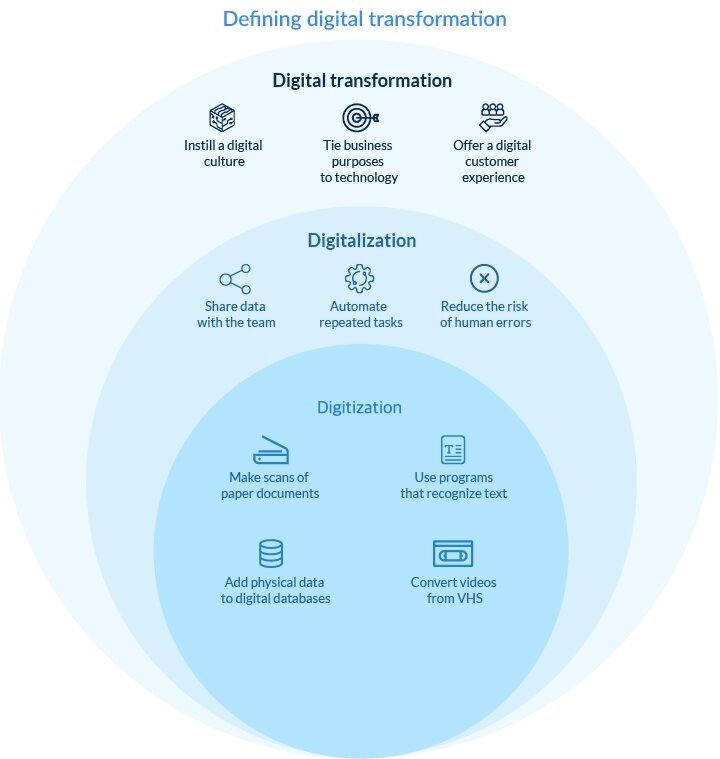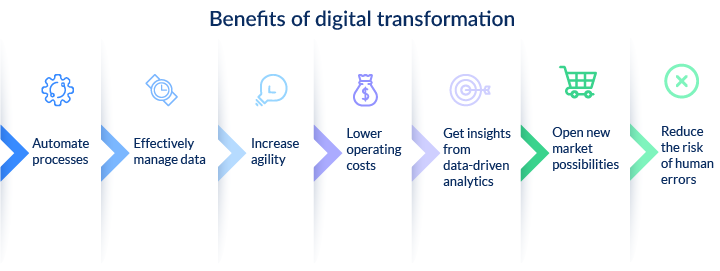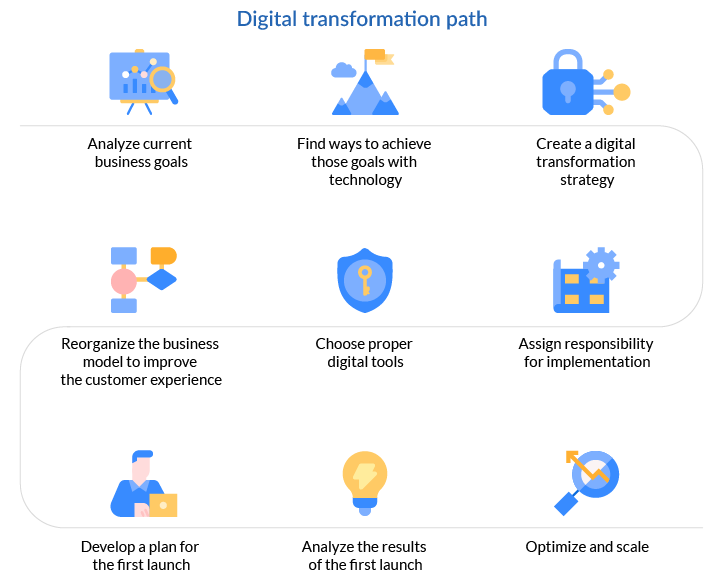Digital transformation. This term appeared 10 years ago and is well known within almost every organization, commercial enterprise, and state. Technology has entered our lives and influenced the way we communicate, run businesses, and the way we think. Digital transformation was a reaction to this disruption as businesses started searching for solutions to adapt to changes. This process has been so beneficial that after 10 years, it’s still gaining momentum. We’ve prepared the article, where you can get all necessary information about what digital business transformation is.
What is digital transformation in business?
Digitization, digitalization, and digital transformation
Misunderstanding key terms related to digital transformation can lead you to false results of digital transformation rollout. To avoid this, you should learn their meanings.
Digitization – Converting data into a digital format
Digitalization – Changing operating processes with the help of technology to find new approaches for revenue growth and to strengthen value propositions
Digital transformation – Shifting the whole business culture to do business in a digital way

In this diagram, you can see variants of actions inside each of these three processes. Digitization and digitalization are parts of digital transformation and serve their own purposes. Digital transformation is the process of reorganizing a business to make it digital, and this process affects a business’s culture, operations, and technology.
Why is digital transformation so important?
When electronic devices began to significantly influence our world, the demand for digital transformation rose. Internet communication, information available in the public domain, and the speed at which data is processed caused changes in customer needs and expectations. Nowadays, if you want to satisfy a client’s requirements, demonstrating a product’s benefits is not enough.
Companies are imposed to analyze a lot of data and use modern computer technologies to better understand potential customer portraits. The speed and quality of services provided affect a business’s viability. Adopting digital is necessary to raise the efficiency and competitiveness of companies. It gives you a power to be agile and quickly adapt to a demanding and sometimes capricious market. Let’s discover what benefits digital transformation can bring.
What are the benefits of digital transformation?
Digital transformation changes business operations big time. Companies learn how to use technology to stay competitive, more profitable, and fit the market. PTC reports that the main benefits of digital transformation are increased working efficiency (40%), faster entrance to market (36%), and increased level of customer satisfaction (35%). Digital transformation saves companies money, improves a product or service, and grows their efficiency. Take a look at more benefits of digital transformation for businesses.

What challenges can digital transformation bring?
Although digital transformation gives businesses a lot of opportunities, it can also bring obstacles. Shifting to digital may be turbulent because:
- Employees can struggle with adopting technology.
- Many digital tools are interconnected, which can make them complex to use.
- There’s a risk of falling for trendy technology without getting actual improvements.
- Competing business objectives can tangle your strategy.
- Threats of cyber attacks can force you to rethink your approach to security.
You can overcome these challenges by aiming attention on strategic planning and prioritizing goals. Clearly define digital transformation success and find responsible and interested people with whom you’ll roll out your digital transformation.
Who introduces digital transformation?
In large corporations, most of the control over digital transformation falls on the Chief Information Officer (CIO). The CIO participates in creating a digital transformation strategy, communicating the plan to employees, choosing technology suppliers, and handling other tasks.
Small businesses can hire business consultants to help assign roles, develop an action plan, and choose technologies.
The alternative is for all employees to be responsible for digital transformation. You can divide employees into small teams and make them responsible for specific tasks and ask them to report on progress.
What are the key steps for a business to be digitally transformed?
Digital transformation requires a lot of effort. It reshapes business objectives, business models, communication within the company, and the customer experience. Technology can change a product or service and transform a marketing strategy. That’s why to perform a successful digital transformation, a company should take the following steps.

What digital transformation tools do I need to succeed in digital transformation?
Choosing the right technology is critical to a successful digital transformation. The main task of any digital tool is to help a business achieve its goals quickly and without hassle. One of the key factors in the choice of technologies will always be a particular tool’s profitability.
If you need to transfer data to a digital format, choose software for text recognition, video conversion, or any other need.
To improve operational processes, choose management software that will speed up and simplify your team’s work. You can hire developers and get a tool for solving a particular problem. The choice of technology will depend on your budget and your business’s complexity.
Digital transformation: success stories

Many companies are starting to actively transform their business strategies for becoming digital. And some are managing to achieve good results. Read success stories and get inspired to grow your business digitally.
How Starbucks uses data to enhance the customer experience
Starbucks was one of the first corporations to successfully bridge the digital and physical worlds. They learned to build trusting relationships with customers on the idea of openness and transparency and made their services more convenient for their clients.
Starbucks began collecting information and preferences from their customers to enhance their marketing strategy. Now they can personalize offers for each customer, increasing sales and reducing expenditures on ineffective advertising.
By developing their own mobile application, Starbucks has made customers’ lives more comfortable. Customers can order and pay for coffee in the Starbucks application and not waste time in queues. Technology has also made it possible to track coffee bean suppliers. Now Starbucks customers can learn more about the coffee they drink and the plantation where the beans were grown.
Coca-Cola’s intelligent vending machines
Coca-Cola uses the Internet of Things to collect data about their customers. The company created smart vending machines to collect data from the busiest vending points and on the most popular drinks. They then used the information they gathered to invent new flavors and better meet customers’ needs. Coca-Cola’s smart vending machines accept payments from mobile wallets and credit cards, support loyalty programs, and send refill notifications to supply managers. These features help Coca-Cola retain customers and improve their products.
Wrapping up
Digital transformation has become a buzzword that many organizations confuse with simply adopting technology. Digital transformation in business is much more complicated and influences business models, strategies, and people. Although the transformation process requires a lot of effort, digital technology is our future. We have to decide whether to embrace digital or stay where we're and maybe lose the opportunities to grow.
Thinking of digitalising your business? Learn how to do it right in our article 4 Key Steps in the Digitalization of Business Processes.
FAQ
-
Misunderstanding key terms related to digital transformation can lead you to false results of digital transformation rollout. To avoid this, you should learn their meanings.
Digitization – Converting data into a digital format
Digitalization – Changing operating processes with the help of technology to find new approaches for revenue growth and to strengthen value propositions
Digital transformation – Shifting the whole business culture to do business in a digital way
-
Digital transformation in business brings such benefits as:
- Processes automation
- Effective data management
- Increased agility
- Lower operating costs
- Open new market possibilities
- Reduce the risk of human errors
-
Although digital transformation gives businesses a lot of opportunities, it can also bring obstacles. Shifting to digital may be turbulent because:
- Employees can struggle with adopting technology.
- Many digital tools are interconnected, which can make them complex to use.
- There’s a risk of falling for trendy technology without getting actual improvements.
- Competing business objectives can tangle your strategy.
- Threats of cyber attacks can force you to rethink your approach to security.



